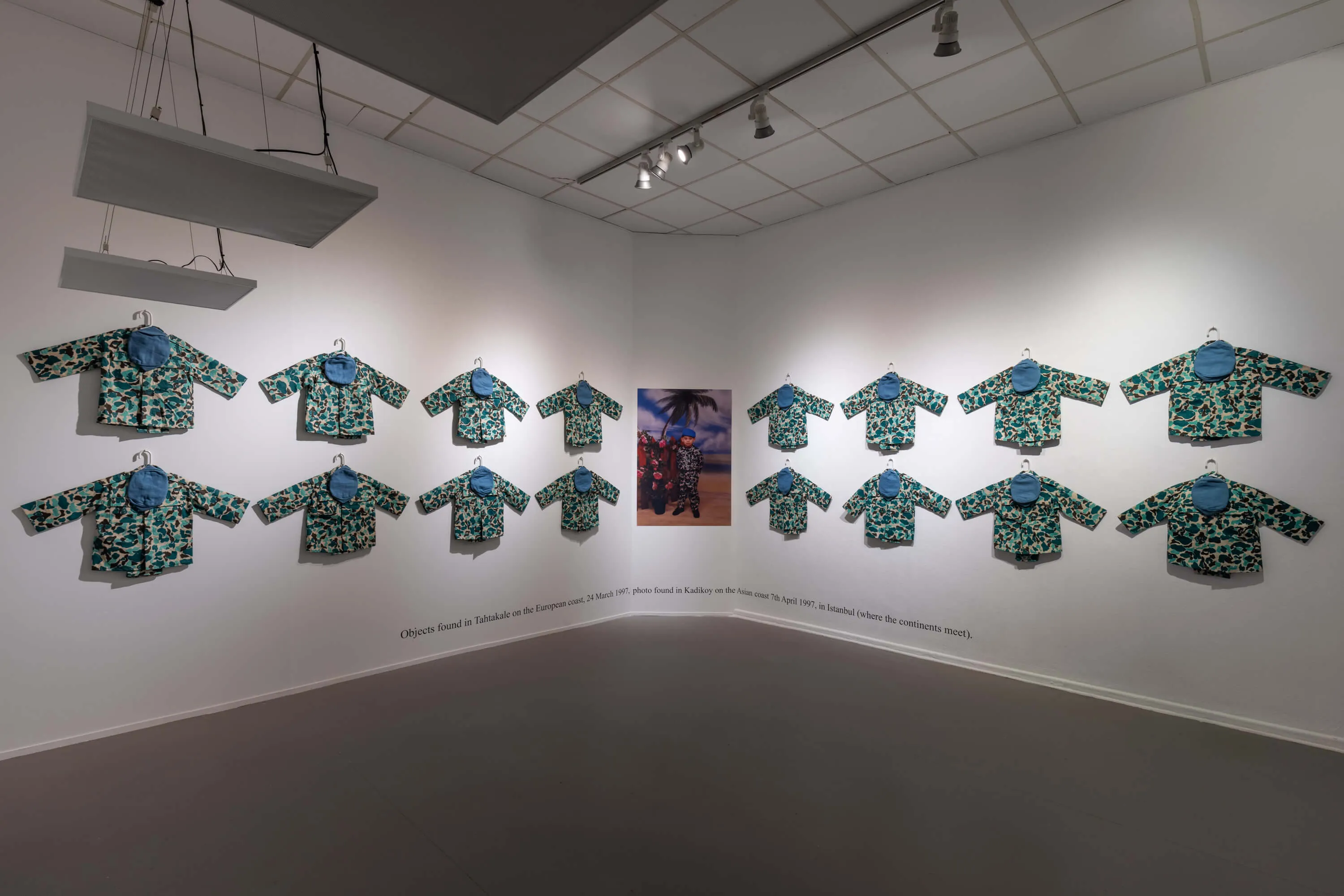Gülsün Karamustafa "Where the Continents Meet"

Installation, 1997
— There’s a practice in Russia where parents buy their children military clothing to celebrate May 9, the holiday commemorating the USSR’s victory in World War II (The Great Patriotic War, as it is called in Russia). An image of a child in camouflage is very familiar and very painful for us as Russian political emigrants. You have a similar tradition in Turkey, right?
— Yes, this situation became widespread during the Cyprus War between the Greeks and Turks, which happened in 1974. It was a severe war situation and since then Turkey considers the Republic of Northern Cyprus a small independent country. Everything turned militaristic in Turkey, and these children’s camouflage dresses were very fashionable at that time, but it never stopped, of course. People like to dress up their children in this way for ceremonies on national holidays.
This project was born in 1997. I saw these dresses on the streets of Istanbul in one of the shops. It had lots of them, maybe hundreds, because this shop was producing them and sending them to places in Anatolia, in Cyprus or wherever. And I said, I should buy some of these so they may become something as a work of art. You never know.
I had only money for the 20 of them. So I took them back to my studio. Then I had a call from an exhibition in a small town in Sweden, Borås. At that time, we were really willing to have some shows outside of Turkey. I thought, well, this is a good occasion to do something and work for this exhibition.
At that time, the Yugoslavian wars had not ended yet. Only two years had passed after the Srebrenica massacre. At the same time, when you look at the Middle East, there were non-stop wars popping up here and there all the time. The name of that show was "Around Us, Inside Us" — that name inspired this work.

With all those wars happening around me, I thought about these small children’s uniforms. So I said, "Why not go around and find a photograph with a child in a uniform like that?" I looked for a photograph in the vitrines of the photographers in Istanbul: it was very fashionable to take such photos.
I found one and asked the photographer for it, and I was very lucky because this was his niece — so we didn’t have any copyright problems. First, the project was shown in Borås, then later in Kunsthalle Fridericianum in Kassel at the "Echolot" show. These are the very early experiences of Turkish contemporary art. It was shown later in my solo show in Istanbul in 2013 at Salt. Now, I think, it is possible to show it again due to repetition of the history.
— Do you have a theory about why parents want to dress their kids as soldiers?
— First of all, it is based on a militaristic feeling. There is always a current of these militaristic feelings in Turkey. Also, for example, there is a ceremony in Turkey — I don’t know whether it happens in other parts of the world — where you send your son to military service, and all his friends and families come together for celebration. They applaud the guy who’s ready to give his life for his country. In all these ceremonies, these small children wear this kind of dress, pretending to be their big brother who is going to war. Families show that they have lots of other children whom they can sacrifice for their country. It’s like a kind of proposal for sacrifice probably.

— That sounds a little like Greek mythology, when Agamemnon kills his daughter as a sacrifice meant to ensure victory in war. Like you have to feed the war with children.
— Yes, wars are fed with children, and children are war’s targets.
Gülsün Karamustafa is one of Turkey’s most renowned contemporary artists. Throughout her career, which spans more than 60 years, she has explored themes of identity, migration and gender, trying to make sense of the changes that urbanization and globalization have brought to her country. Karamustafa works in a variety of media, from traditional figurative painting to installation and film.
Born in Ankara in 1946, she graduated from the State Academy of Fine Arts in Istanbul in 1969. In 1971, the conflict between right-wing and left-wing political groups in Turkey reached its peak, and the military staged a coup d’état, claiming it would put an end to the unrest.
Gülsün Karamustafa and her husband Sadık were imprisoned for taking part in the protests: he served two and a half years, she six months. The artist has reflected on her experience of political persecution in a number of projects, including the cycle "Prison Paintings", created in 1972 and first exhibited in 2013.
Karamustafa has received many awards, both Turkish and international, including the Dutch Prince Claus Award. She has participated in major exhibitions around the world and represented her country at the Venice Biennale in 2024. Karamustafa’s first major solo exhibitions took place at Salt Beyoglu and Galata in Istanbul in 2013, and outside Turkey at the Nationalgalerie der Gegenwart (Hamburger Bahnhof) in Berlin in 2016. The artist’s work is included in the collections of the Tate Modern, the Guggenheim Museum in New York, the Ludwig Foundation in Vienna, Istanbul Modern and many other institutions.